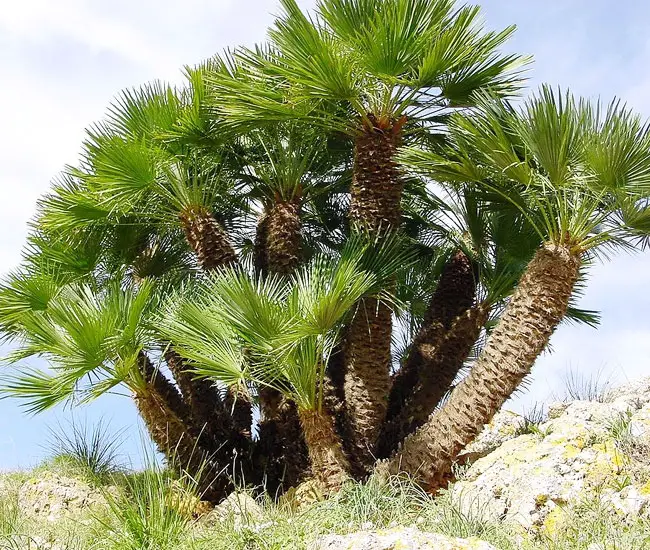
Palms are one of the most famous and widely grown plant families out there. You won’t believe it, but there are over 2,500 different species of palm trees in the world, belonging to around 202 genera.
Most of these beauties call tropical, subtropical, or warm temperate climates their home sweet home. Now, here’s where it gets interesting.
While palms thrive in warm spots, some tough ones can even handle chilly temperatures as low as 10 degrees Fahrenheit!
They also come in various sizes and growth patterns – from solitary trunks to clusters of trunks or even vining habits.
But what really sets them apart are those magnificent leaves. They can come in all sorts of shapes and colors. With such diversity, it’s easiest to tell them apart by their looks and botanical features.
What Are The Different Types Of Palm Trees
Palm trees can be grouped into major categories based on their trunk, leaf structure, growth speed, size, and how well they handle the cold. But wait, there’s more! They also differ in their ability to withstand drought, salt, and their fruit and flower production.
If you are trying to identify a palm tree, you should check out my article on palm tree identification where I go into more detail about palm tree frond structure, type of trunks, and other characteristics.
In this post, I want to list the most popular types of palm trees that gardeners ask for when coming to the nursery. I broke them into 7 main categories with the top 5 most popular palms in each.
Top 7 Categories of Palm Trees
- Small Palm Trees: Also known as Dwarf Palms or Miniature Palms, these cuties won’t grow taller than 20 feet. And since they’re usually slow growers, there’s no need for a separate category.
- Fast Growing Palm Trees: Now, these palms are the sprinters of the palm world. They put the pedal to the metal and can grow up to a whopping 2.5 feet per year!
- Cold Tolerant Palm Trees: AKA Cold Hardy Palms, these champs can take the cold like a pro, handling temperatures as low as 5-20 degrees Fahrenheit. They’re good to go in USDA Zone 8 and even 7b.
- Fruit Producing Palm Trees: These palms are not just pretty faces; they produce some delicious fruits, perfect for chowing down on raw or cooked.
- High Drought Tolerant Palms: Some palms are practically superheroes when it comes to surviving drought. They’re tough, adaptable, and built to last.
- Highly Salt Tolerant Palms: If you’re living by the coast and want some greenery in your life, these palms are your best buddies. They can handle the salty breeze like it’s no big deal.
- Indoor Palms: Now, for those of us who want a bit of the tropics in our homes, small palms are a fantastic choice. They’re perfect for containers and can handle various soil types and even low humidity.
Small Palm Trees
Palm trees come in all shapes and sizes, and that includes how fast they grow and how tall they get. Small Palm Trees, also known as Dwarf Palm Trees or Miniature Palms, tend to be the slow and steady types.
They usually stay under 20 feet, which makes them just perfect for those cozy little landscapes. You can make ’em the star of the show or nestle them under those bigger trees for some extra flair. Here are the top 5 most popular small palm trees:
1. European Fan Palm (Chamaerops humilis)
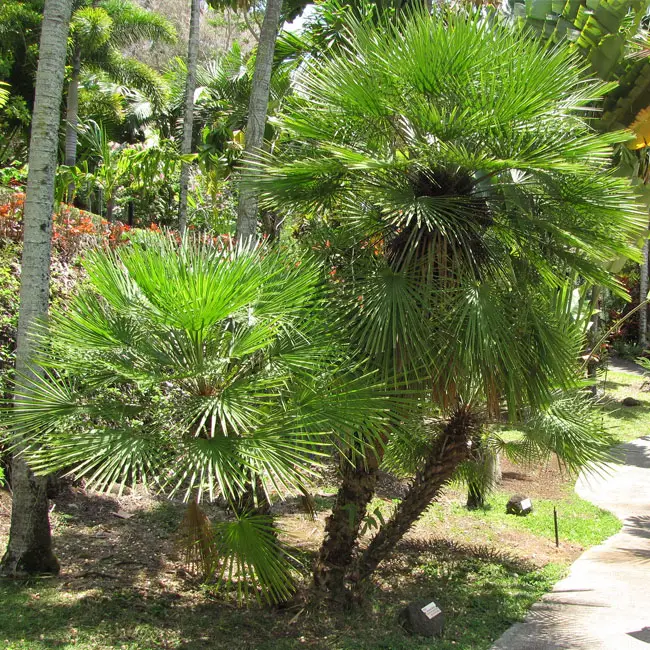
The European Fan Palm, also known as Mediterranean Fan Palm, is a little guy is a compact palm tree, usually reaching a maximum height of about 10 feet.
Now, what makes it stand out are those multiple trunks and those leafy wonders that look like perfect semicircles. And hey, speaking of leaves, they can be all shades of cool – think olive, blue-green, or even a trendy silvery blue.
Now, here’s where it gets interesting. This palm is a Mediterranean native, which means it’s like the region’s superstar. It’s super adaptable when it comes to soils and not too needy once it’s all settled in.
Plus, it’s a champ when it comes to handling drought, and it doesn’t shy away from a bit of a chilly breeze, tolerating temps as low as 10 degrees Fahrenheit. So, if you’re after a fuss-free, tough-as-nails palm, this one’s got you covered!
2. Bottle Palm (Hyophorbe lagenicaulis)
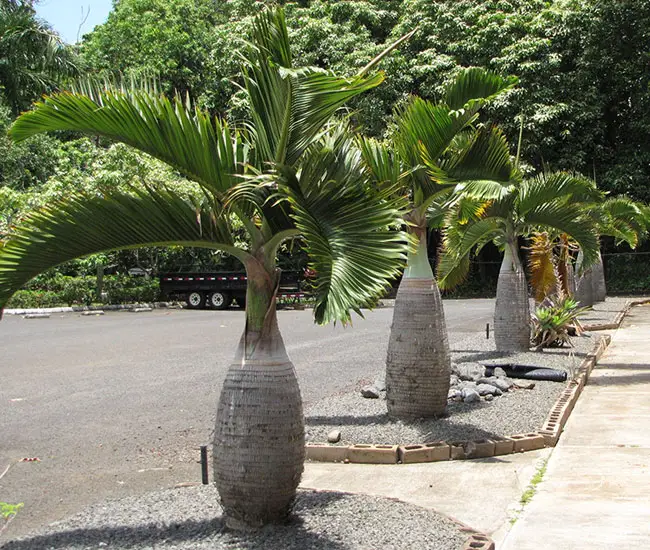
Hailing from the beautiful Mascarene Islands, this palm has quite the unique look, which earned it the name “Bottle Palm.”
It boasts a trunk that’s all rounded, just like a bottle. It’s not in a hurry to grow either, taking its time to reach a max height of around 12 feet.
The real showstopper is that gray, chubby trunk, crowned with these gracefully curved, glossy dark leaves.
Now, here’s the deal with the Bottle Palm – it’s all about that sunny life and can handle some serious salt. But, and it’s a big but, it’s not a fan of freezing temperatures, so you gotta keep it cozy.
People love using this palm as the star of the show in their landscapes, and who can blame them? That unique shape is just too good to pass up!
3. Lipstick Palm (Cyrtostachys renda)
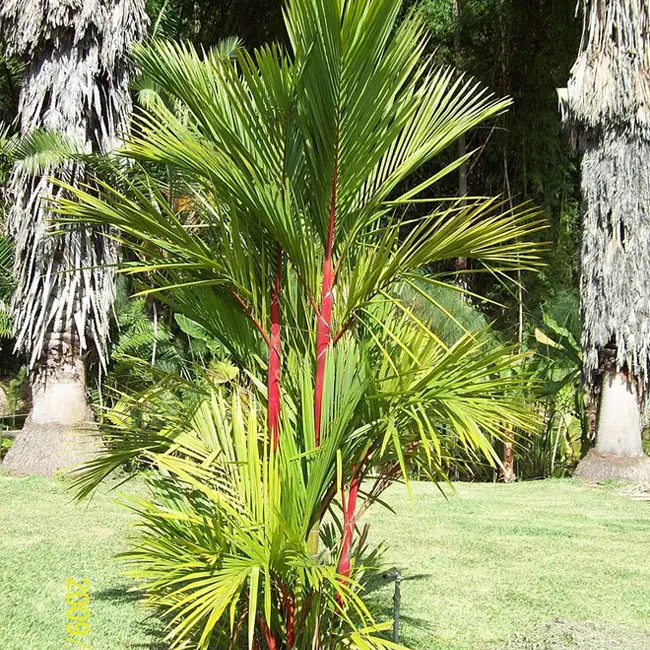
The Lipstick Palm, also known as the Sealing Wax Palm, is native to Southeast Asia. It’s got quite the flashy feature that gives it its name – the long, bright red crownshaft that looks just like a tube of lipstick, extending right up through the leaf stem.
The leaves are quite the sight too, reaching up to a whopping 4 feet in length. They’re a vibrant green on top and a lighter shade underneath, adding a nice pop of color to your landscape.
As for its size, this palm usually grows up to around 15 feet tall. The best part? It’s a pretty easygoing plant, adaptable to various conditions and generally trouble-free. People often use it as a screen or hedge because it’s just that awesome!
4. Pindo Palm (Butia capitata)
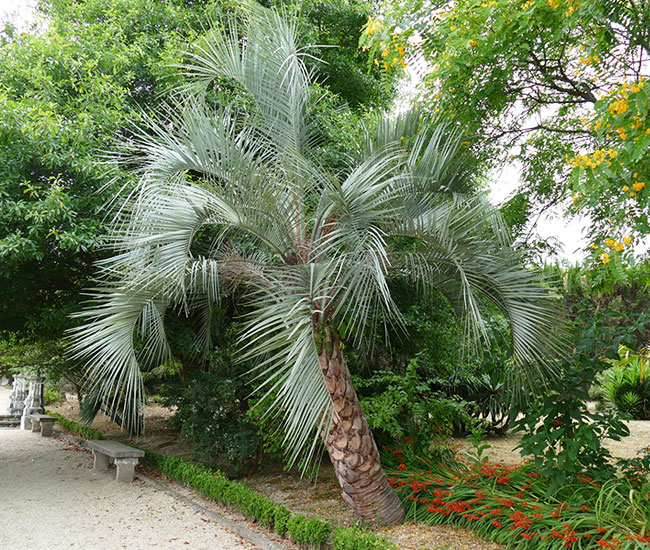
Coming straight from the heart of Brazil, we’ve got a palm that’s a real treat – the Jelly Palm. It earned its sweet name thanks to its delicious fruits that taste just like jelly. How cool is that?
This palm is quite hardy, shrugging off cold snaps even when temperatures drop as low as 10 degrees Fahrenheit. But it truly thrives in the warm conditions of USDA Zone 10B.
Stunning arching blue-green leaves crown an 18-inch-thick trunk that’s covered in old leaf bases. The Pindo Palm is quite the adaptable character and can go without a drink for a while, making it a champ in drought-prone areas.
Oh, and it’s got that star quality too – perfect for taking center stage in your landscape. Plus, it’s not in a hurry to grow, gracefully reaching up to 15 feet over time.
5. Pygmy Date Palm (Phoenix roebelenii)
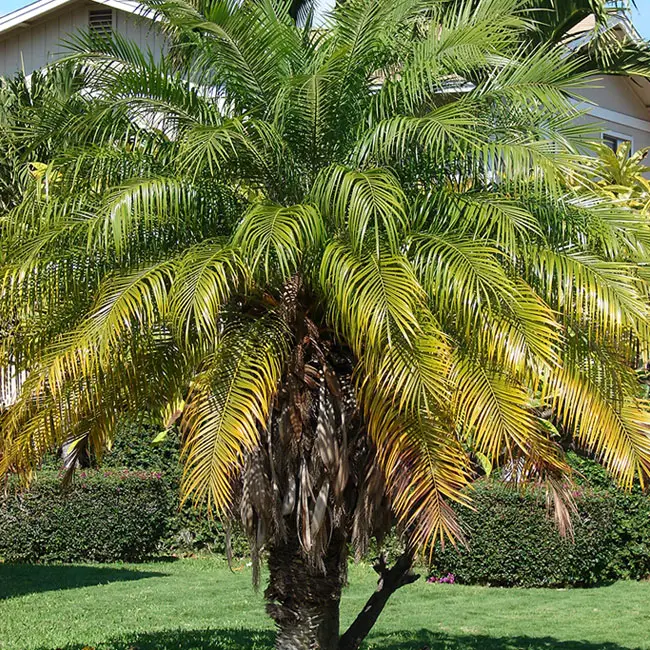
The Pygmy Date Palm is incredibly versatile due to its compact size, making it a fantastic addition to your landscape whether you want to feature it as a charming focal point or nestle it among other lush foliage plants for a delightful composition.
This palm is a gradual grower, reaching a height of up to 10 feet while developing a lush crown adorned with shiny, dark green leaves, and be mindful, it does come with sharp spines along its stems.
For this palm to thrive, it’s all about regular watering and soaking up the full sun. However, it’s not too keen on the cold, with its tolerance dropping to only around 30 degrees Fahrenheit.
Fast Growing Palm Trees
Fast-growing palm trees are a real asset for gardeners looking to save both time and money while crafting their ideal landscape.
These palms are all about speed, rapidly developing massive overhead canopies that offer shade and shield you from that scorching sun.
Now, remember, the growth rate isn’t set in stone; it dances to the tune of the growing environment – things like soil type, the number of sunny days, humidity levels, and moisture in the air.
Palms in Florida, for instance, might put on a growth sprint compared to their counterparts in California.
So, without further ado, here are the top 5 fast-growing palms that can transform your landscape in the blink of an eye:
1. Carpentaria Palm (Carpentaria acuminata)
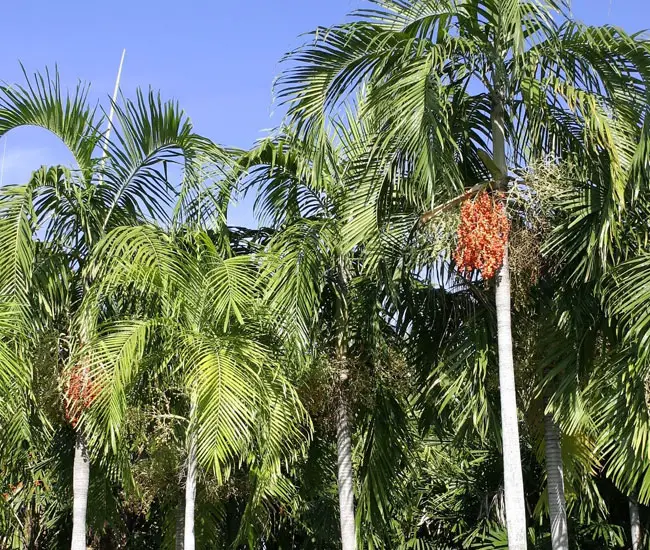
The Carpentaria Palm, hailing from the land Down Under in Australia, displays a sleek, solitary trunk graced by a magnificent cluster of gracefully arching fronds.
It’s a fast riser, shooting up to impressive heights of 30-40 feet. In ideal conditions, it’s like a rocket, growing about 3 feet a year.
But here’s the catch: the Carpentaria Palm is a real softy when it comes to the cold, and it’s definitely not a fan of droughts. So, make sure you keep it cozy and well-hydrated if you want it to thrive!
2. Foxtail Palm (Wodyetia bifurcata)
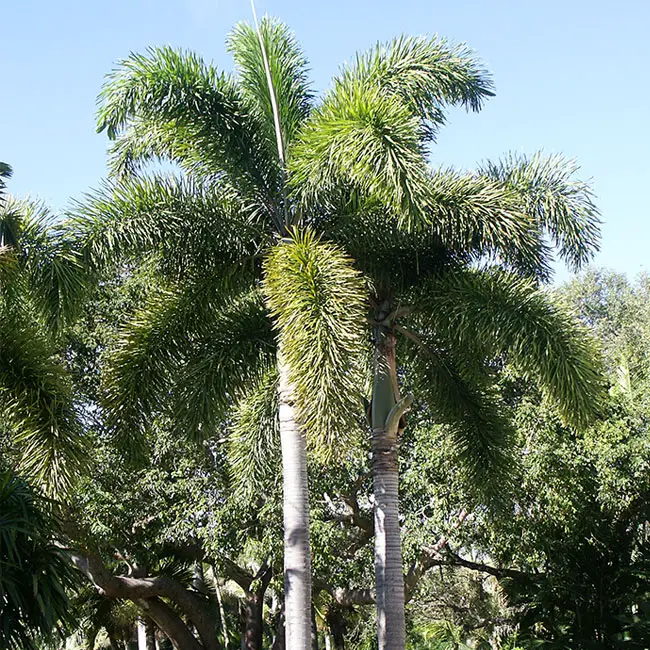
Originating from Northern Australia, the Foxtail Palm has been gaining popularity year after year. This palm is a rapid grower when it comes to growth, shooting up to 20 feet in no time and capping off at a max height of 30 feet.
It’s a versatile one, fitting in well with various soil types, basking in full sun, and even handling a touch of chilly weather.
3. Majesty Palm Tree (Ravenea rivularis)
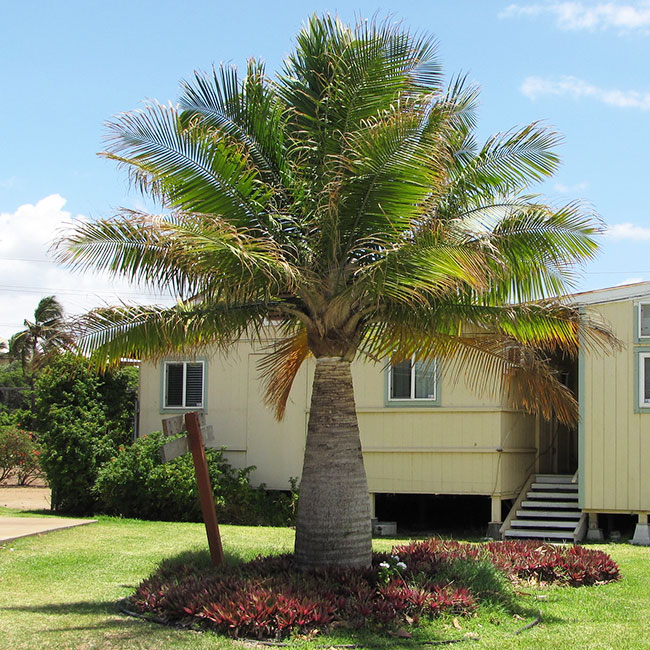
Majesty Palm, known for its speedy growth, can quickly reach 10 feet in just 10 years, growing at a rate of about 1 foot per year, after which its growth rate significantly slows down.
Its maximum height potential is around 35 feet, but typically, it doesn’t exceed 20 feet. Majesty Palms thrive in moderate shade and benefit from regular fertilization.
4. Mexican Fan Palm (Washingtonia robusta)
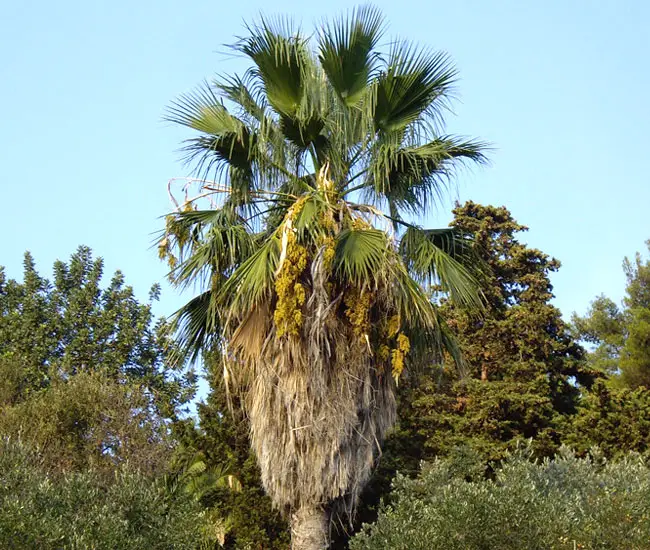
The Mexican Fan Palm, which goes by various names like Washington Palm and Skyduster, is a fast-growing palm that hails from its native Mexico.
Under the right conditions, it can shoot up at a rate of approximately 2 feet per year, eventually reaching its towering peak at around 70 feet.
This palm is quite the champion when it comes to adapting to various soil types, extremely resilient in the face of drought, and surprisingly unfazed by chilly weather, holding strong even when temperatures dip down to 20 degrees Fahrenheit.
5. Queen Palm (Syagrus romanzoffiana)
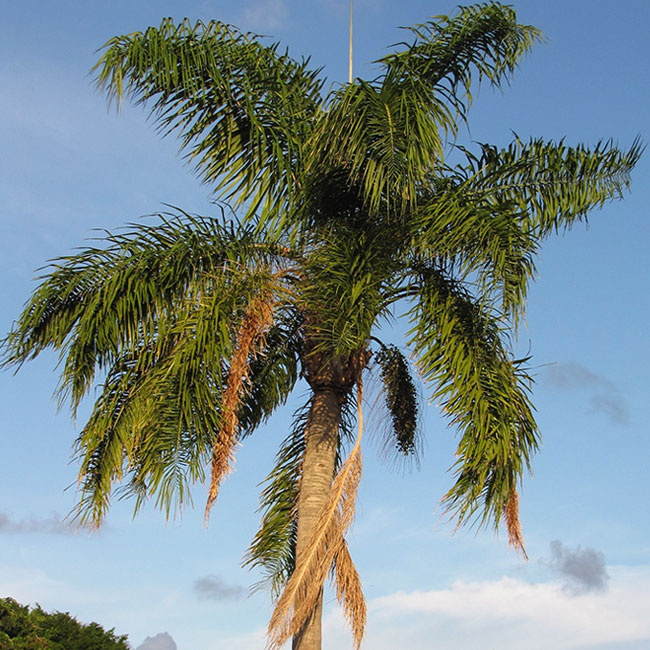
The Queen Palm, which also goes by the names Cocos Plumosa and Jeriva Syagrus romanzoffiana, is a beloved choice for its rapid growth. In just 7 years, it can sprout from a 15-gallon plant to a majestic 25 feet, boasting an impressive growth rate of 3.5 feet per year.
This palm thrives in full sun, soaking up those rays with joy, and it’s a real trooper when it comes to pests and diseases – rarely bothered by those pesky issues.
Cold Tolerant Palm Trees
While many palms are known for their love of warm weather, there are some hardy ones that can tough it out in chilly conditions, enduring temperatures as low as 10 to 15 degrees Fahrenheit, making them suitable for Zone 8.
And then, there are the true warriors of the cold, often dubbed “cold hardy palms,” which can survive even lower temperatures, provided they’re well-established.
Of course, it’s always a good idea to have a cold weather backup plan, just in case those frosty nights decide to stick around. So, without further ado, here’s a list of the 5 most popular cold hardy palm trees that can brave the chill and still thrive in your landscape:
1. Bismarck Palm (Bismarckia nobilis)
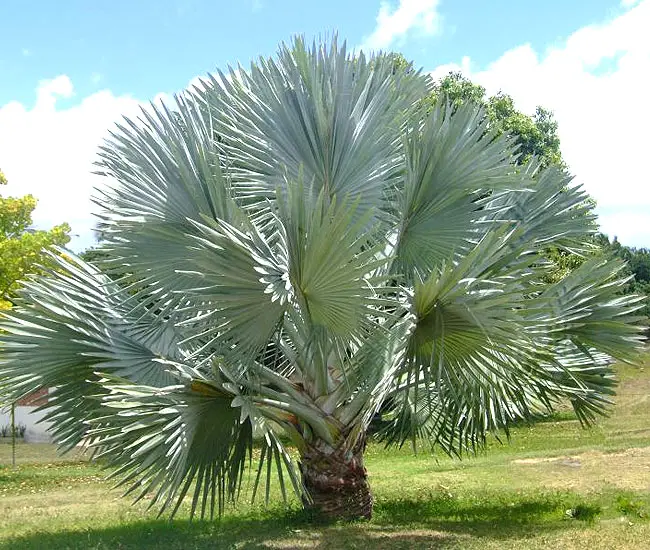
The Bismarck Palm, known by various names like Bismark Palm, Bismarckia Palm, and Nobilis Palm, is truly a sight to behold and a fan favorite for its stunning appearance.
This palm is incredibly versatile, showing off its adaptability and impressive drought tolerance. When it’s mature enough, it can even brave the cold, withstanding temperatures as low as 15 degrees Fahrenheit.
It’s a fantastic choice for regions ranging from Zone 8b (where temperatures drop to 15-20 degrees Fahrenheit) all the way to Zone 11 (where temperatures stay above 40 degrees Fahrenheit).
2. California Fan Palm (Washingtonia filifera)
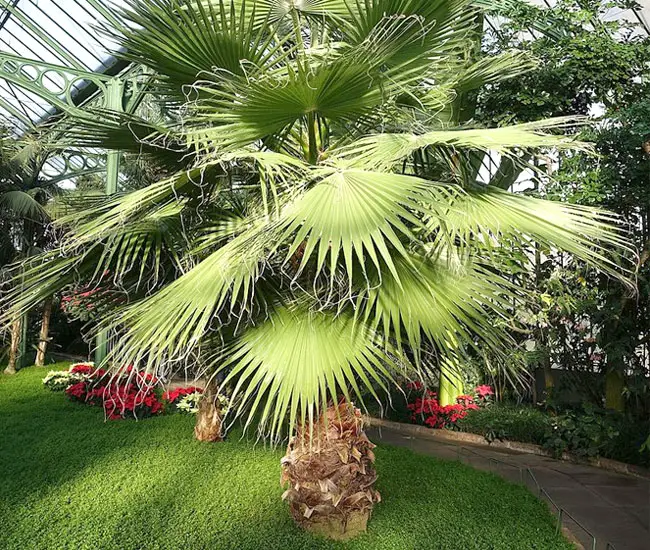
The California Fan Palm, which goes by several names like Desert Fan Palm, American Cotton Palm, and Arizona Fan Palm, is a tough cookie when it comes to cold weather, holding its ground even when temperatures drop as low as 15 degrees Fahrenheit once it’s mature enough.
This palm is an excellent choice for regions spanning from USDA Zone 8b (where temperatures range from 15 to 20 degrees Fahrenheit) to Zone 11 (where it stays above 40 degrees Fahrenheit).
And it’s not just cold-tolerant; it’s also a champ in drought-prone areas and can adapt to a wide range of conditions.
3. Chinese Fan Palm (Livistona chinensis)
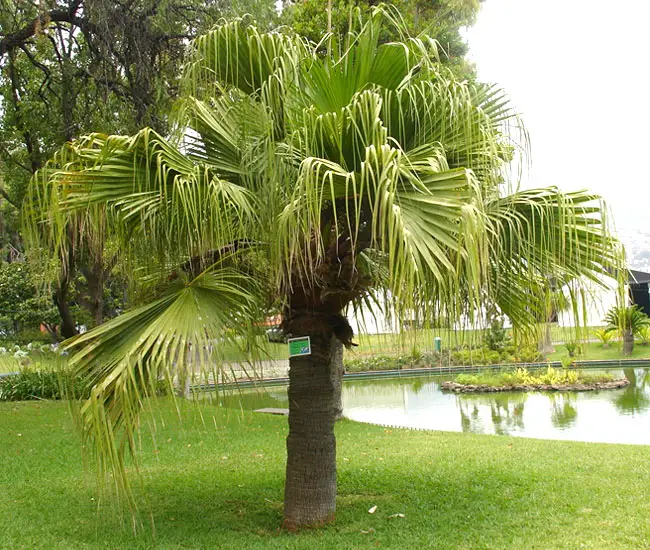
The Chinese Fan Palm, recognized by names like Chinese Fountain Palm and Fountain Palm, is a resilient contender against the cold, handling temperatures as low as 15 degrees Fahrenheit with ease.
This makes it an ideal choice for USDA Zone 8b (where temperatures range from 15 to 20 degrees Fahrenheit) through to Zone 11 (where it stays above 40 degrees Fahrenheit).
What’s more, this palm is a superstar in drought-prone regions and can effortlessly adapt to a wide variety of soil types.
4. Needle Palm (Rhapidophyllum hystrix)
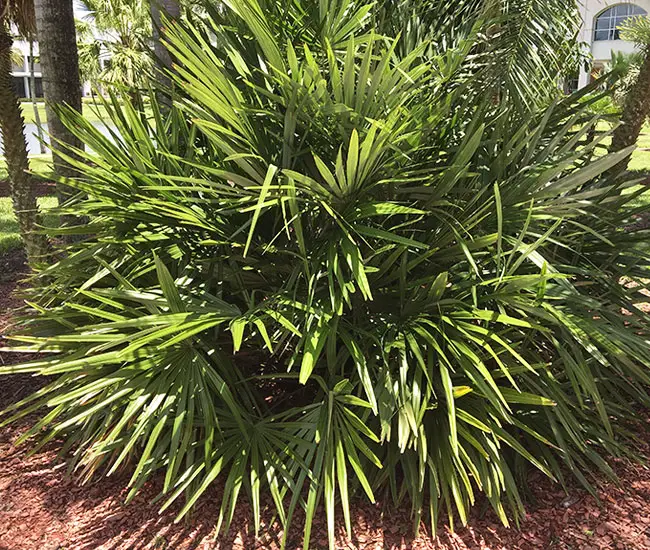
The shrub-like palm, sometimes referred to as the Porcupine Palm, is a true cold warrior, braving temperatures as low as 10 degrees Fahrenheit and even lower when it’s firmly established.
This palm is a fantastic addition to landscapes in USDA zones ranging from 7b (where temperatures range from 5 to 10 degrees Fahrenheit) to Zone 11 (where it stays above 40 degrees Fahrenheit).
Not only is it cold-hardy, but it also boasts high drought tolerance and easily adapts to a wide array of soil types.
5. Windmill Palm (Trachycarpus fortune)
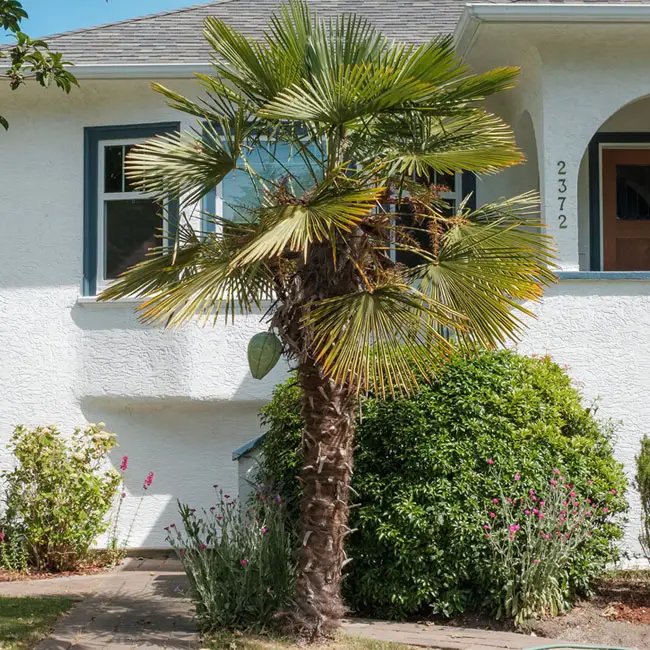
The Windmill Palm, known by various names including Chusan Palm and Chinese Windmill Palm, is a true tough nut in the palm world, capable of standing tall in freezing temperatures as low as 5 degrees Fahrenheit without a scratch.
This palm finds its happy place in USDA zones ranging from 7b (where temperatures range from 5 to 10 degrees Fahrenheit) to 10b (with temperatures in the 35-40-degree range). Interestingly, despite its Chinese origins, it’s not a fan of hot tropical climates.
Fruit Producing Palm Trees
Having a palm tree in your landscape that not only adds a tropical vibe but also serves up delicious fruits is truly a win-win. So, here are the top 5 palms known for their delectable fruits:
1. Acai Palm (Euterpe oleracea)
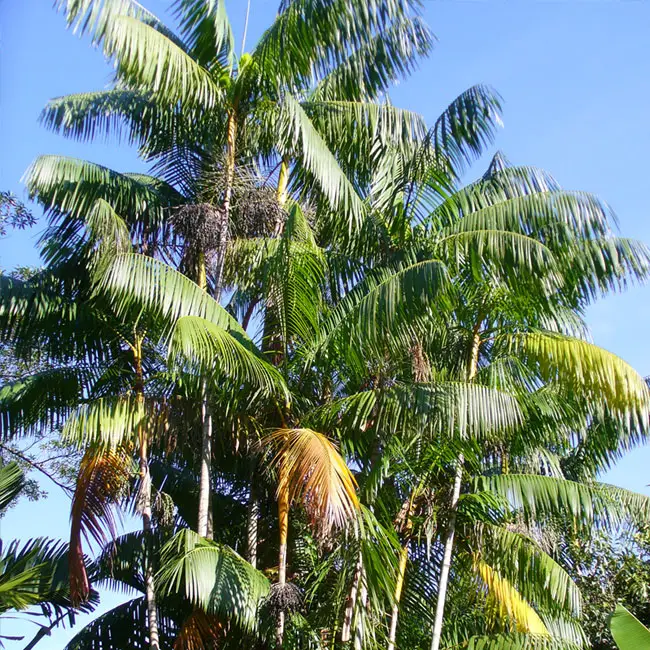
The Areca Palm, known for its elegant fronds, is renowned for its delectable and nutritious fruits, rich in antioxidants, amino acids, and essential omegas.
These little powerhouses find their way into energy drinks, weight loss products, and cholesterol-lowering goodies.
However, this palm isn’t the best at handling drought conditions, and it’s not a fan of chilly weather.
It thrives in the balmy embrace of USDA Zones 10a (where temperatures range from 30 to 35 degrees Fahrenheit) to Zone 11 (where it stays above 40 degrees Fahrenheit).
2. Coconut Palm (Cocos nucifera)
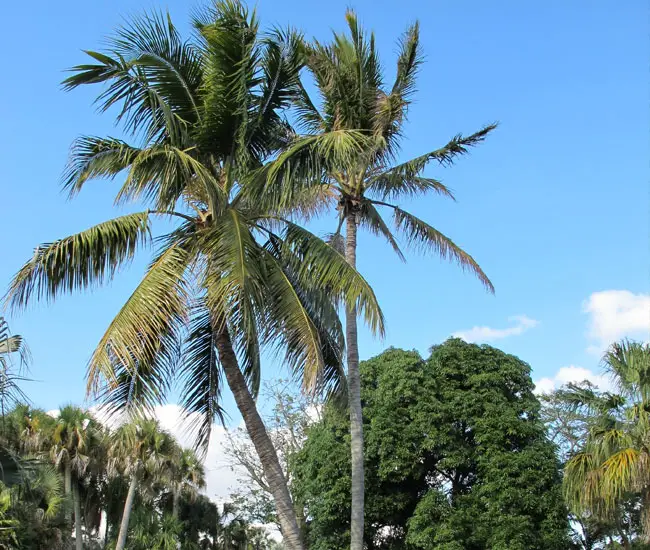
The Coconut Palm, arguably the most economically significant palm, is celebrated for its prized fruit known as the ‘coconut,’ which boasts a delightful combination of white coconut “meat” and sweet, refreshing coconut milk.
These palms are prolific fruit-bearers, offering up their coconuts throughout the year, with each palm tree producing an impressive annual yield of around 50-200 coconuts.
The coconut isn’t just a tasty treat; it’s also a valuable source for oil production, and the fiber from the husk of the fruit finds its way into various manufacturing processes.
3. Date Palm (Phoenix dactylifera)
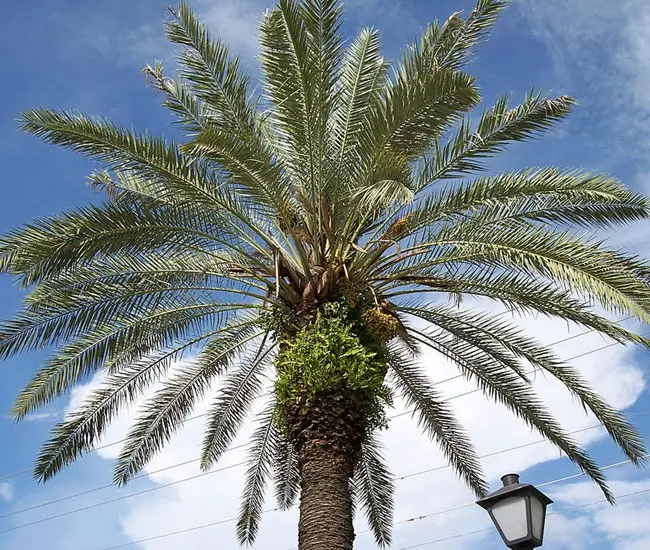
The True Date Palm, which goes by an impressive array of names including Date Palm, True Date, Medjool Palm, Medjool Date Palm, Phoenix Medjool Palm, Jewel Palm, Medjewel Palm, and Medjool Dates, is renowned for its bountiful harvest of orange-red fruits known as ‘dates.’
These dates are a natural wonder, boasting an irresistibly sweet flavor reminiscent of a cross between a fig and a prune.
But that’s not all; they’re incredibly versatile, finding their way into a wide range of culinary delights, from ice creams and syrups to vinegars and alcoholic beverages.
4. Jelly Palm (Butia capitata)

The Pindo Palm, which goes by the names Jelly Palm and Wine Palm, stands out as the hardiest feather-leafed palm cultivated for landscaping.
What truly sets it apart are its orange fruits, which harbor a delightful, tropical flavor reminiscent of pineapple and banana.
These delectable fruits are often used to create incredibly tasty jelly, hence its fitting moniker, the Jelly Palm.
5. Saw Palmetto Palm (Serenoa repens)
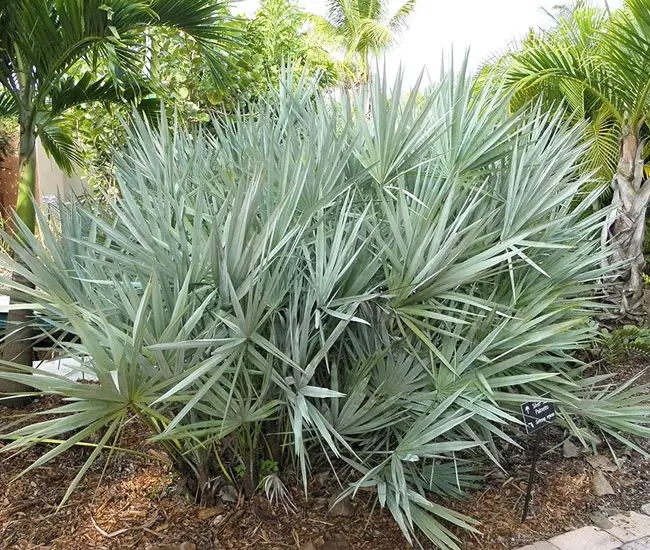
This cold-hardy palm, recognized by various names such as Silver Saw Palmetto Palm and Scrub Palm, is not only rugged but also a source of healing.
It yields black-blue berries that are harnessed for medicinal purposes, particularly in the treatment of kidney, prostate, and urinary problems.
Additionally, this palm’s yellow-white, fragrant flowers are transformed into honey, adding another layer of usefulness to this remarkable tree.
High Drought Tolerant Palms
Palm trees, originating from diverse climate zones, exhibit varying degrees of drought tolerance. While all palms require moisture, some can endure longer periods of dry soil, with those native to desert environments boasting the highest drought tolerance.
However, several factors come into play, including the age of the palm, humidity levels, sun exposure, and wind conditions.
It’s important to note that newly planted palms, even if they are naturally drought-tolerant, demand frequent watering and are less likely to withstand a drought.
Here are the top 5 drought-tolerant palms:
1. Areca Palm (Chrysalidocarpus lutescens)
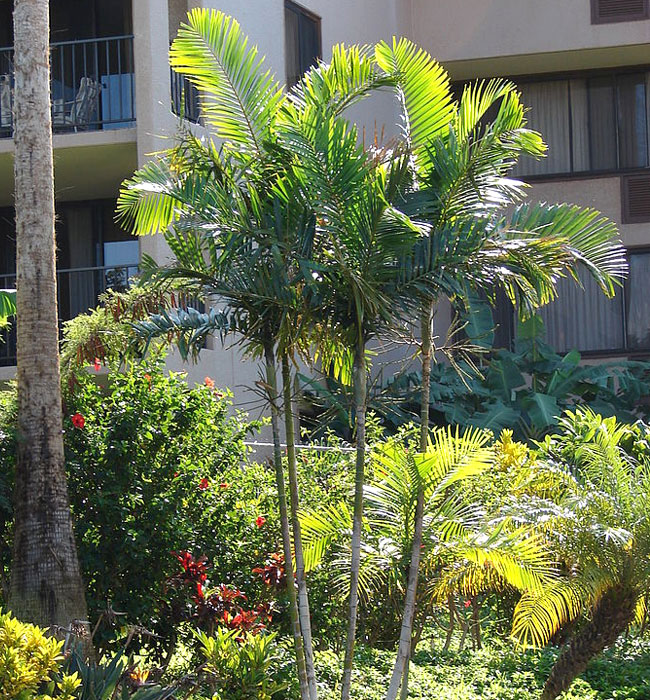
The Areca Palm, known by a multitude of names including Butterfly Palm, Cane Palm, Madagascar Palm, Golden Feather Palm, and Yellow Palm, has gained widespread popularity in subtropical and tropical regions.
Originally hailing from the islands of Madagascar, this palm is not only a favorite but also highly resilient, showcasing impressive drought tolerance and a knack for adapting to a wide variety of soil types.
2. Blue Hesper Palm (Brahea armata)
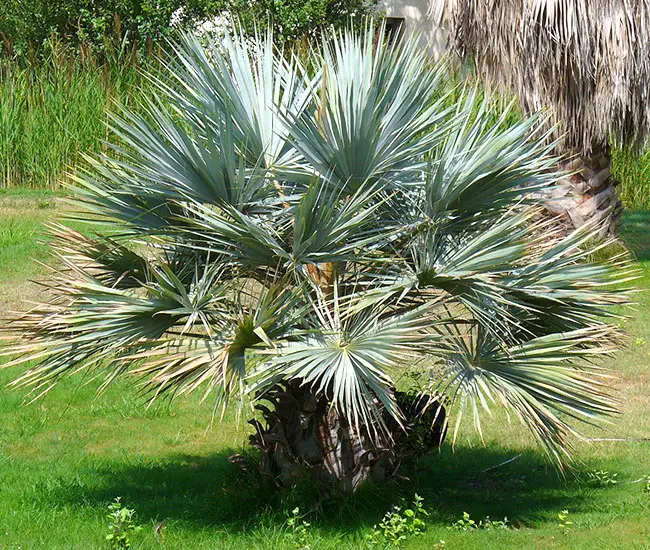
The Blue Hesper Palm, which goes by several names including Mexican Blue Palm, Blue Palm, Sweet Brahea Palm, and Gray Goddess, is a striking palm known for its captivating canopy of ice-blue leaves.
Originating from Mexico, this palm boasts impressive drought tolerance and thrives in alkaline soil conditions. It’s a fantastic choice for USDA Zones 9b through 11, adding a touch of elegance to landscapes in those regions.
3. Blue Latan Palm (Latania loddigesii)
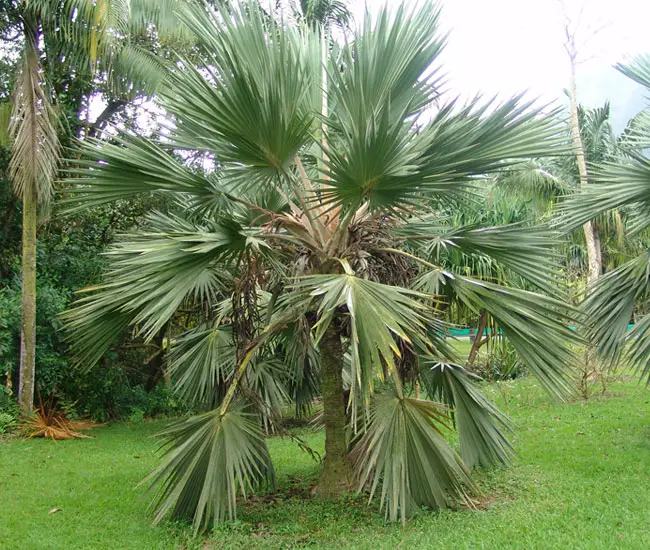
The Blue Latan Palm, recognized by names like Blue Latan and Blue Latania Palm, is a captivating palm known for its distinct coloration, although the intensity of the color tends to fade as the palm ages.
Hailing from the picturesque Mauritius Island, this palm is exceptionally drought-tolerant and showcases impressive adaptability to a wide array of soil types.
4. Canary Island Date Palm (Phoenix canariensis)
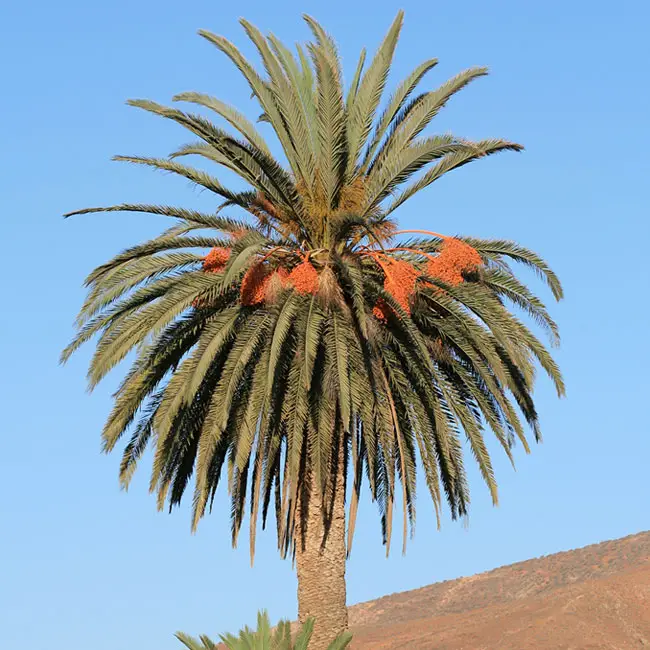
The hardy palm, recognized by a variety of names including Canary Island Date Palm, Canary Palm, Pineapple Palm, and Canary Island Palm, lives up to its reputation as an exceptionally tough and resilient species.
Originating from the Canary Islands and North Africa, this palm is a true survivor, capable of enduring drought, poor soil conditions, and even low temperatures, standing strong all the way down to 15 degrees Fahrenheit.
It’s a remarkable addition to landscapes spanning USDA Zones 8b (where temperatures range from 15 to 20 degrees Fahrenheit) to Zone 11 (where it stays above 40 degrees Fahrenheit).
5. Sylvester Date Palm (Phoenix sylvestris)
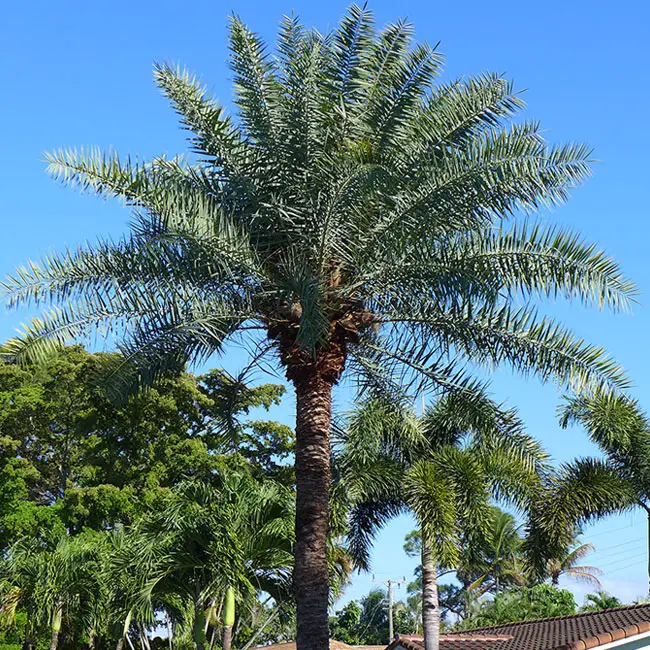
The Sylvester Date Palm, which goes by various names including Sugar Date Palm, India Date Palm, Silver Date Palm, and Wild Date Palm, shares striking similarities with the Phoenix canariensis but sets itself apart by not producing suckers and having shorter leaves.
Originating from India, this palm is incredibly resilient, showcasing adaptability to a wide range of soil types, a tolerance for cold temperatures as low as 15 degrees Fahrenheit, and a remarkable ability to withstand drought conditions.
Highly Salt Tolerant Palms
Palms that thrive in coastal areas boast impressive salt tolerance, making them ideal choices for your landscape if you reside near the water’s edge. Here is my list of the top 5 salt-tolerant palms:
1. Buccaneer Palm (Pseudophoenix sargentii)
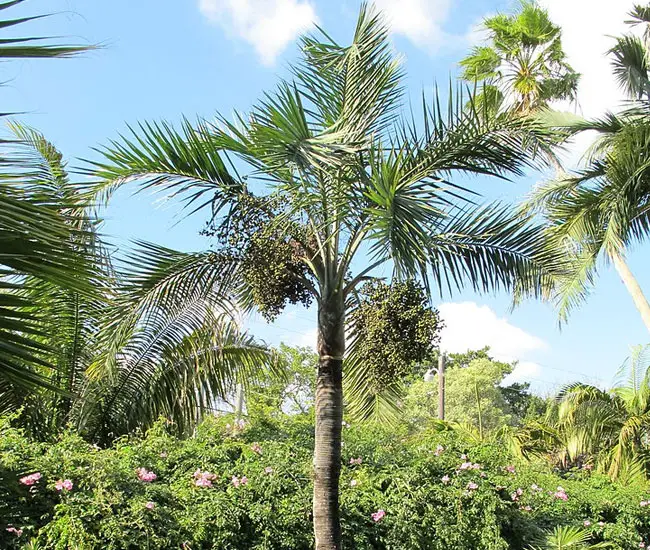
The Buccaneer Palm, recognized by a variety of names including Cherry Palm, Sargent’s Cherry Palm, and Palma de Guinea, stands as one of Florida’s hardiest palm varieties.
This palm is typically hassle-free, boasting impressive resilience against drought and salt. It’s a fantastic choice for USDA Zones 10b through 11, adding a touch of durability to coastal landscapes.
2.Cabbage Palm (Sabal palmetto)
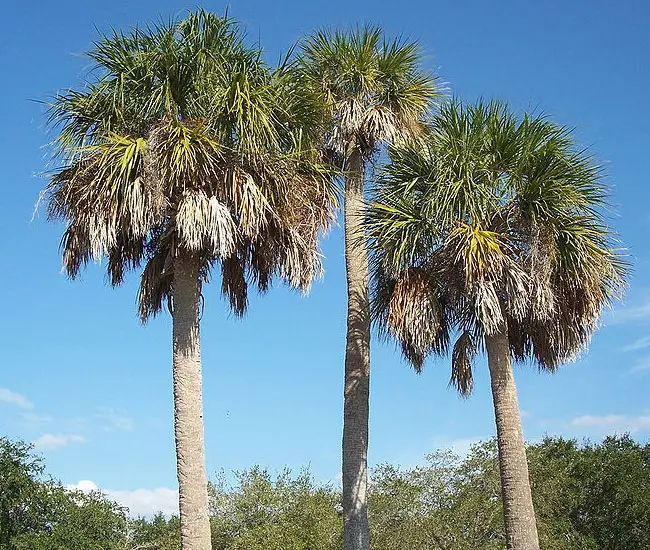
The Cabbage Palm, also recognized as the Sabal Palm, has earned its reputation as one of the most beloved and extensively used palm trees in the United States, thanks to its outstanding durability.
This palm isn’t just widely adaptable; it’s also a champion when it comes to salt tolerance, drought tolerance, and cold tolerance. It can bravely weather frigid temperatures as low as 10 degrees Fahrenheit, solidifying its place as one of the hardiest palms around.
3. Old Man Palm (Coccothrinax crinita)
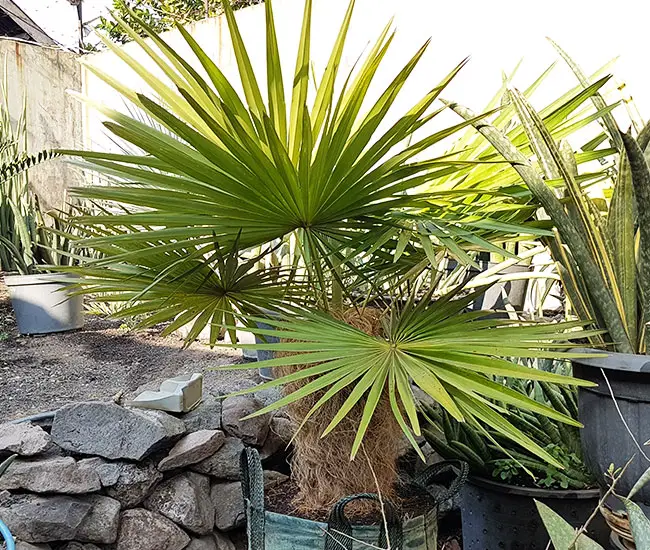
The Old Man Palm, a delightful fan palm remarkable for the long shag of hair around the trunk, may not be the most drought-tolerant choice, but it adapts well to alkaline soils and showcases remarkable salt tolerance.
It’s an excellent addition to landscapes in USDA Zones 10b through 11, bringing its unique charm to coastal areas.
4. Saw Palmetto Palm (Serenoa repens)
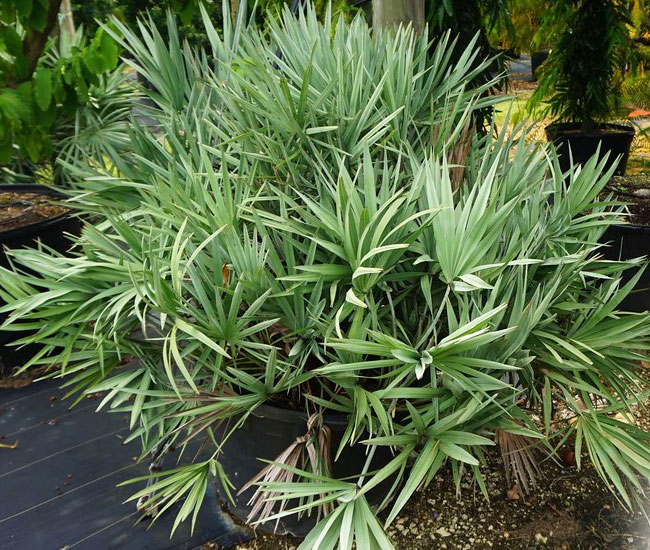
The Saw Palmetto Palm, an incredibly durable species, could easily earn a spot in every category, given its impressive attributes. It boasts cold tolerance, drought tolerance, salt tolerance, a compact size (reaching only 3-6 feet), and even produces edible fruits.
Known by names like Silver Saw Palmetto Palm and Scrub Palm, it’s a true survivor, capable of enduring temperatures as low as 10 degrees Fahrenheit and even lower.
This bushy, slow-growing palm showcases its adaptability across a wide range of soils and shines as a perfect choice for container gardening.
5. Spindle Palm (Hyophorbe verschaffeltii)
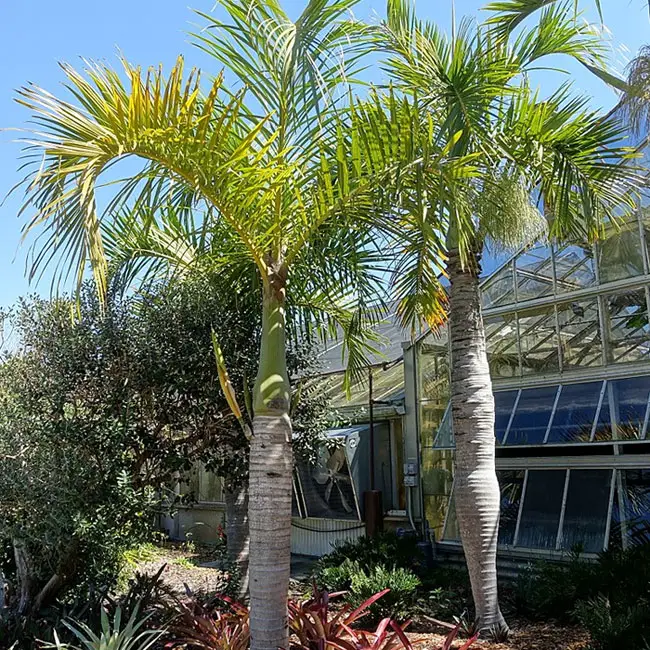
The Spindle Palm bears a striking resemblance to the Bottle Palm, thanks to its swollen trunk, but it boasts a touch more hardiness and a slightly greater stature.
Thriving in full sun, this palm effortlessly adapts to a wide range of conditions and proudly showcases its salt tolerance. It’s an excellent choice for USDA Zones 10b through 11, adding a touch of elegance to coastal landscapes.
Indoor Palms
Palm trees don’t just bring a tropical ambiance; they also contribute to air purification when cultivated indoors. While many palm trees can thrive indoors, even in low light and humidity, certain varieties handle indoor conditions more gracefully.
For indoor cultivation, your best bet is to go for slow-growing palms that demonstrate adaptability to various soil types. When selecting an indoor palm, it’s crucial to factor in its potential mature size.
Here are the top 5 most popular indoor palm trees:
1. Areca Palm (Chrysalidocarpus lutescens)
The Areca Palm takes the crown as one of the most beloved indoor palms. With its long, light green fronds boasting a feather-like appearance and narrow leaflets, it brings a touch of tropical elegance to your indoor space.
This palm’s growth rate clocks in at approximately 7 inches per year, eventually reaching a height of around 7 feet indoors. It thrives in an environment with ample indirect light, demands regular watering, and prefers well-drained soil to keep those fronds flourishing.
2. Bamboo Palm (Chamaedorea seifrizii)
The Bamboo Palm, which also goes by names like Reed Palm, Clustered Parlor Palm, and Cane Palm, is a fantastic choice for indoor cultivation, thanks to its remarkable ability to thrive in low light conditions, low humidity, and less-than-ideal soil.
When nurtured indoors, it typically reaches a height of around 10 feet and spreads to a width of 4 to 5 feet, providing an elegant touch of greenery to your living space.
3. Kentia Palm (Howea forsteriana)
The Kentia Palm, hailing from Australia, is yet another favored selection for an indoor palm. Its charming feather-shaped fronds and clustering trunk add an air of elegance to any indoor setting.
This palm proves highly adaptable to low-light conditions and typically reaches a height of around 7 feet when grown indoors. In lower light settings, it may bear 4-6 fronds, but when exposed to medium light levels, it rewards you with twice as many lush fronds.
4. Ponytail Palm (Beaucarnea recurvata)
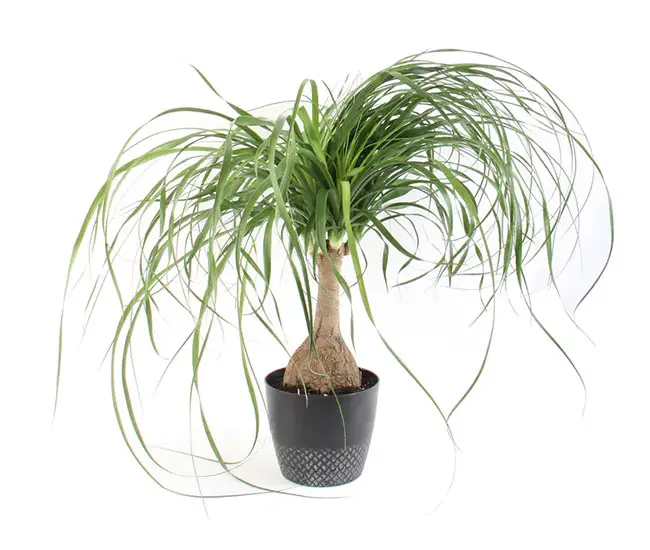
One of the most user-friendly and forgiving indoor palms is the Ponytail Palm. It showcases long, hair-like, curly leaves that gracefully cascade from a single, sleek trunk, earning it the charming moniker “Ponytail Palm.”
You might also hear it referred to as Pony Tail Palm, Elephant-Foot Tree, Elephant Foot, Monja, or Palma culona.
This palm boasts impressive tolerance for low-light conditions and typically reaches a height of up to 6 feet when nurtured indoors, making it a delightful addition to your indoor green oasis.
5. Sago Palm (Cycas revoluta)
The Sago Palm, although not a true palm but rather a cycad, enjoys immense popularity, often mistaken for a palm due to its similar appearance. This slow-growing, cold-tolerant plant can reach heights of about 5-7 feet when cultivated indoors.
Interestingly, it can take anywhere from 70 to 100 years for the Sago Palm to achieve its maximum height. However, a word of caution if you have pets: this palm is toxic if ingested, so it’s important to keep it out of their reach.
To see more popular palms check out our palm tree catalog.
Related articles:
–20 Amazing Palm Tree Landscape Design Ideas (with Pictures)
–What Palm Trees Are Native To United States
–10 Most Popular Fast Growing Palm Trees
–Palm Tree Care 101: Ultimate Guide to Health & Happy Palms

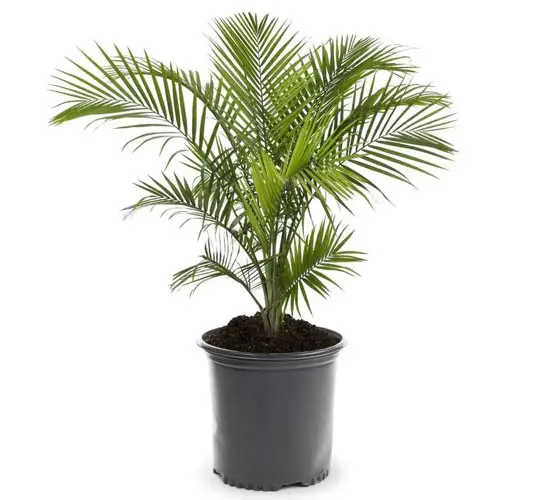
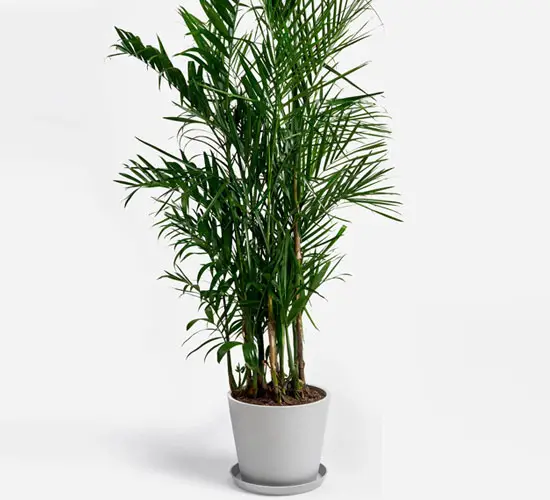
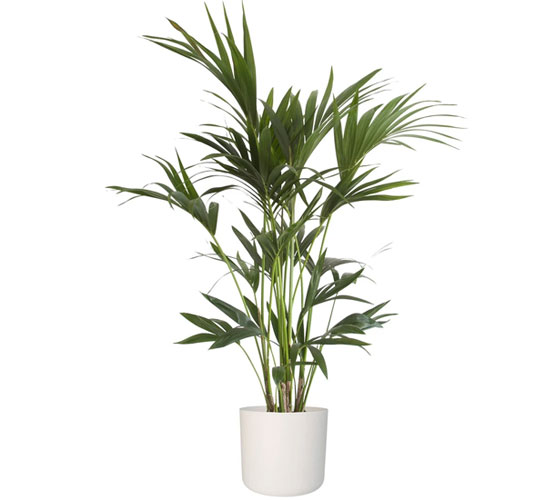
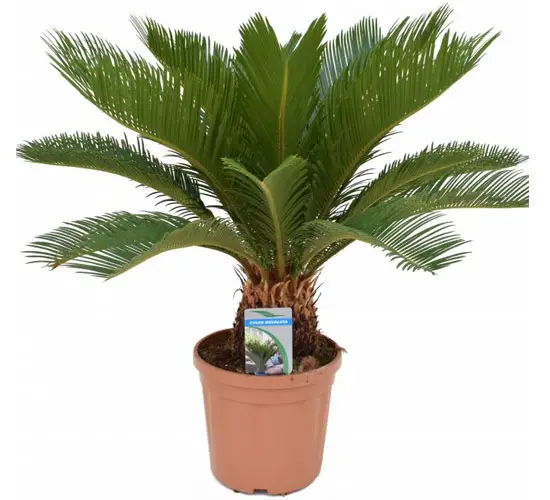
Hi, I find your articles very educational. Some pictures, especially the ones sprinkled throughout the article, don’t show up though possibly because of broken links. I tried different browsers but that didn’t make any difference.
Thank you,
Peter
What causes palm trees to be stubbed. Grow leaves then dies. I can send pictures
I’m well aware that I’m trying to do the impossible,but am often successful in doing the impossible because I research and work hard at what I want and don’t give up. My current quest is to grow a coconut producing palm 50 miles north of Tampa, Fl. I have it in a huge rope handled plastic pot in my green house. It was flourishing at about 4 1/2′ tall til the unusually long lasting cold weather recently seemed to kill it’s long beautiful fronds, though it’s roots seem undamaged. I had a heat lamp in the green house but the wind tore the plastic top off one day. I brought the palm inside as soon as I noticed damage. All my pineapples in the greenhouse survived, tho I lost one outside along with 4 mangos. My kiwis did fine outside. My question is what’s the best thing, or things I can do for it while waiting to see if it can recover?
I have a queen palm for the last 7 years. this year on the bottom of the palm a green strange thing is growing and all around the tree there are palms growing. should I cut them down? what should I do.
thanks for your time
I have a palm that grows up with the leaf together and as he gets older it splits and makes feathery leave wondering what the name of it is could you help me with this